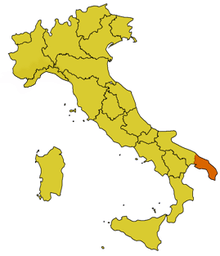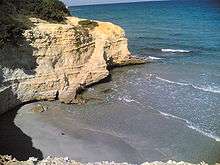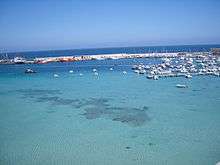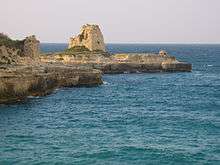Salento
Salento (Salentu in Salentino romance dialect, Σαλέντο in Salentino Griko) is a geographic and historical region at the southern end of the administrative region of Apulia in Southern Italy. It is a sub-peninsula of the Italian Peninsula, sometimes described as the "heel" of the Italian "boot". It encompasses the entire administrative area of the province of Lecce, a large part of the province of Brindisi and part of that of Taranto.

The peninsula is also known as Terra d'Otranto, and in the past Sallentina. In ancient times it was called variously Calabria or Messapia.
History
Messapia (from Greek Μεσσαπία) was the ancient name of a region of Italy largely corresponding to modern Salento. It was inhabited chiefly by the Messapii in classical times. Pokorny derives the toponym from the reconstructed PIE *medhyo-, "middle" and PIE *ap-, "water" (Mess-apia, "amid waters"). Pokorny compares the toponym Messapia to another ancient Italic toponym, Salapia, "salt water", a city in Apulia.
Geography



Salento peninsula is composed of limestone, dividing the Gulf of Taranto to the west from the Strait of Otranto on the east, with the Adriatic Sea to the north and the Ionian Sea to the south. Known also as "peninsula salentina", from a geo-morphologic point of view it encompasses the land borders between Ionian and the Adriatic Seas, to the “Messapic threshold”, a depression that runs along the Taranto-Ostuni line and separates it from the Murge.
Its borders are:
- Taranto, in the Province of Taranto
- Pilone, in the territory of Ostuni, in the Province of Brindisi
- Santa Maria di Leuca, in the Province of Lecce.
Cities and towns in Salento
Province of Lecce
Acquarica del Capo, Alessano, Alezio, Alliste, Andrano, Aradeo, Arnesano, Bagnolo del Salento, Botrugno, Calimera, Campi Salentina, Cannole, Caprarica di Lecce, Carmiano, Carpignano Salentino, Casarano, Castri di Lecce, Castrignano de' Greci, Castrignano del Capo, Castro, Cavallino, Collepasso, Copertino, Corigliano d'Otranto, Corsano, Cursi, Cutrofiano, Diso, Gagliano del Capo, Galatina, Galatone, Gallipoli, Giuggianello, Giurdignano, Guagnano, Lecce, Lequile, Leverano, Lizzanello, Maglie, Martano, Martignano, Matino, Melendugno, Melissano, Melpignano, Miggiano, Minervino di Lecce, Monteroni di Lecce, Montesano Salentino, Morciano di Leuca, Muro Leccese, Nardò, Neviano, Nociglia, Novoli, Ortelle, Otranto, Palmariggi, Parabita, Patù, Poggiardo, Porto Cesareo, Presicce, Racale, Ruffano, Salice Salentino, Salve, San Cassiano, San Cesario di Lecce, San Donato di Lecce, San Pietro in Lama, Sanarica, Sannicola, Santa Cesarea Terme, Scorrano, Seclì, Sogliano Cavour, Soleto, Specchia, Spongano, Squinzano, Sternatia, Supersano, Surano, Surbo, Taurisano, Taviano, Tiggiano, Trepuzzi, Tricase, Tuglie, Ugento, Uggiano la Chiesa, Veglie, Vernole, Zollino.
Province of Brindisi
Brindisi, Carovigno, Cellino San Marco, Erchie, Francavilla Fontana, Latiano, Mesagne, Oria, Ostuni, San Donaci, San Michele Salentino, San Pancrazio Salentino, San Pietro Vernotico, San Vito dei Normanni, Torchiarolo, Torre Santa Susanna, Villa Castelli.
Province of Taranto
Avetrana, Carosino, Faggiano, Fragagnano, Grottaglie, Leporano, Lizzano, Manduria, Maruggio, Monteiasi, Monteparano, Pulsano, Roccaforzata, San Giorgio Ionico, San Marzano di San Giuseppe, Sava, Taranto, Torricella.
Language
Salento, from a cultural and linguistic point of view, does not include the city of Taranto, where the Tarantino dialect is spoken, nor the part of the province of Taranto to the west of the city (where Pugliese is the dialect generally spoken), nor the rest of the province of Brindisi to north of Ostuni (where the accent is influenced by the dialect of Bari).
To the south and east of the above areas, the Sicilian dialect of Salentino is prevalent, although an old Hellenic dialect (known as Griko) is also spoken in a few inland towns.
The most popular hypothesis on the origin of Griko is the one by Gerhard Rohlfs[1] and Georgios Hatzidakis, that Griko's roots go as far back in history as the time of the ancient Greek colonies in Southern Italy and Sicily in the eighth century BC. The Southern Italian dialect is thus considered to be the last living trace of the Greek elements that once formed Magna Graecia.
There are, however, competing hypotheses according to which Griko may have preserved some Doric elements, but its structure is otherwise mostly based on Koine Greek, like almost all other Modern Greek dialects.[2] Thus, Griko should rather be described as a Doric-influenced descendant of Medieval Greek spoken by those who fled the Byzantine Empire to Italy trying to escape the Turks. The idea of Southern Italy's Greek dialects being historically derived from Medieval Greek was proposed for the first time in the 19th century by Giuseppe Morosi [3].
Transportation
The nearest international airports are those of Brindisi and Bari (the latter is out of Salento but not far).
A 2-lane freeway connects Salento to Bari. The main railway line ends at Lecce. Other locations are served by regional railroads.
Leisure ports are those of: Taranto, Brindisi, Campomarino di Maruggio's tourist and leisure Marina, Gallipoli, Santa Maria di Leuca, Otranto.
Coastal towers
The coastal towers in Salento are coastal watchtowers, as the peninsula's coast was long subject to maritime attacks by the Saracens. The first towers may have been built by Normans. The remaining historic towers are mostly from the 15th and 16th centuries. Many are now in ruins.[4][5][6]
Food and gastronomy
Some of the popular dishes from the Salento area include:
- Orecchiette, 'ear-shaped' pasta, often cooked with tomato sauce and a strong creamy cheese called ricotta schianta, or with rapini
- Parmigiana di melanzane, made with aubergines and tomato sauce
- Pitta di patate, a savoury pie made with mashed potatoes
- Turcinieddhri, grilled lamb offal
- Purciaddruzzi, fried hand-made small cookies with honey, eaten during Christmas time
Gallery
.jpg)

References
![]()
![]()
![]()
- G. Rohlfs, Griechen und Romanen in Unteritalien, 1924.
- G. Horrocks, Greek: A history of the language and its speakers, London: Longman. 1997. Ch. 4.4.3 and 14.2.3.
- G. Morosi, Studi sui dialetti greci della terra d'Otranto, Lecce, 1870.
- "The Towers Of Salento in Apulia - South Italy". Nel Salento. Retrieved 2009-08-17.
- "The vacances dans les Pouilles - Italy". Retrieved 2005-01-10.
- "The beaches of Pouilles - Italy". Retrieved 2018-06-20.